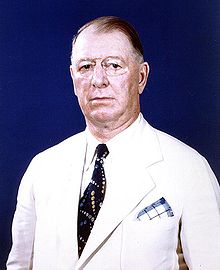Frank Knox | |
|---|---|
 Knox, c. 1940s | |
| 47th United States Secretary of the Navy | |
| In office July 11, 1940 – April 28, 1944 | |
| President | Franklin D. Roosevelt |
| Preceded by | Charles Edison |
| Succeeded by | James Forrestal |
| Personal details | |
| Born | William Franklin Knox January 1, 1874 Boston, Massachusetts, U.S. |
| Died | April 28, 1944 (aged 70) Washington, D.C., U.S. |
| Resting place | Arlington National Cemetery |
| Political party | Republican |
| Spouse | Annie Reid |
| Education | Alma College (BA) |
| Military service | |
| Allegiance | |
| Branch/service | United States Army |
| Years of service | 1898 1917–1919 |
| Rank | Colonel |
| Battles/wars | Spanish–American War • Battle of Las Guasimas • Battle of San Juan Hill World War I |
William Franklin Knox (January 1, 1874 – April 28, 1944) was an American politician, soldier, newspaper editor, and publisher. He was the Republican vice presidential candidate in 1936 and Secretary of the Navy under Franklin D. Roosevelt during most of World War II. On December 7, 1941, Knox, flanked by his assistant John O’Keefe, walked into Roosevelt's White House study around 1:30 pm EST, and announced that Japan had attacked Pearl Harbor.
Born in Boston, he attended Alma College and served with the Rough Riders during the Spanish–American War. After the war, he became a newspaper editor in Grand Rapids, Michigan, and state chairman of the Republican Party. He was a leading supporter of Theodore Roosevelt, the Progressive candidate for president in 1912. He advocated U.S. entrance into World War I and served as an artillery officer in France. The 1936 Republican National Convention nominated a ticket of Alf Landon and Knox, and they were defeated by Roosevelt and John Nance Garner in the 1936 election.
After World War II broke out in 1939, Knox supported aid to the Allies. In 1940, Roosevelt appointed him as Secretary of the Navy in hopes of building bipartisan support. Knox brought in James Forrestal as the under secretary. They presided over a massive naval buildup but were dissatisfied by the confused chain of command in Hawaii. After the attack on Pearl Harbor, Knox brought in a much more aggressive admiral, Ernest J. King. Roosevelt worked closely with King and largely neglected Knox. During the war, Knox continued his supervision of the Chicago Daily News, while Forrestal expanded his role and supervised the nonmilitary aspects of the department in terms of contracts and recruitment.[1] Knox served as secretary of the Navy until his death in 1944, when Forrestal replaced him.
- ^ Lobdell, 1980.